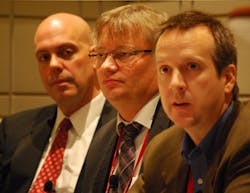Check out ControlGlobal.com on Google+
There was a time when industrial manufacturers had large engineering departments that made all the decisions on how their machines would look and operate. But more and more, that breadth and depth of expertise is leaving the building, and manufacturers are instead handing their specs to machine builders and leaving it to them to figure out how to get the job done.The OEMs, meanwhile, look to their automation suppliers to get the tools they need to ease machine design and development. Much of that is geared toward building smarter machines—more integrated, more sustainable, safer machines that provide the information and diagnostics machine builders and users need. And it needs to be done easier and cheaper in the long run.
"We hear a lot about total cost of ownership, but that's not the right message for machine builders," said Christopher Zei, vice president of the global industry group at Rockwell Automation. "Instead, we need to talk about total cost to design, develop and deliver."
Zei led a discussion among machine builders and users this afternoon at the Global Machine & Equipment Builders Industry Forum as part of Rockwell Automation's Automation Fair in Philadelphia. Panel members discussed the new requirements they face in building smart machines and the way they are tackling those demands.
Diagnostics and Data
Panelists Sweet, Fecht and Wicks (left to right) discussed how global machine builders are leveraging networking technology to better serve their customers' needs.
The discussion focused primarily on the information and diagnostics capabilities of smart machines—how the OEMs are leveraging the wealth of information that's available on machines today to build competitive advantage or reduce costs."Cost is a big deal," said Matt Wicks, vice president of systems engineering for Intelligrated, which provides automated material handling systems. "We're leveraging the technology and integrated architecture to reduce not only the hardware cost, but the engineering cost, and also the cost of servicing the equipment."
Intelligrated not only accesses the data on its machines, but is able to take action to keep those systems running more smoothly. The company gets data out of its high-speed sorters, for example, to recognize problems early. "We monitor the amount of chain sag that we have over time and determine what maintenance needs to happen," Wicks said, explaining that they are able to react to the data and do some tensioning of the chains. "We use this as a competitive advantage."
Focke uses machine data to get a better view of the bigger picture, according to Heino Fecht, automation and design development manager for Focke. The German packaging machine supplier began using PackML, which defines a common language for automated machines. "We have the latest 500 stop codes, so if there's a problem we can see why a machine has stopped," Fecht said, noting that the open standard makes it easier to access codes and correct issues. "We usually can track and sort the most common fault codes and get better performance."
Ethernet Everywhere
Like most, if not all of the panel members, Focke uses EtherNet/IP for machine communications. "We started seven years ago to eliminate other networks, and now we use only EtherNet/IP," Fecht reported. Although it was a bit of a struggle to get employees used to the switch, the move has been good, he added. "Now we're looking to eliminate Sercos."
Spoolex, a French company that makes converting equipment for web-formed products, has replaced DeviceNet and ControlNet with EtherNet/IP and is gradually replacing Sercos with CIP Motion, according to Sebastien LeGris, automation and engineering manager for Spoolex.
Michael Sweet, director of MES at First Solar, agreed that it was difficult to get everybody on board at first, but the move to EtherNet/IP has been a good one. "We've seen a lot of advantages," said Sweet, who brought a user's perspective to the discussion. First Solar makes photovoltaic modules for the solar energy industry and has been able to make use of the integrated logic, Sweet said. In the past, First Solar had to interlock machines to pass the product from one to another. "Now we've created an electronic interlock through EtherNet/IP. All of it is pre-packaged now; very plug and play."
Speaking to the plug-and-play aspects, Lorenzo Razo, engineering manager for Hybernya Industrial in Irapuato, Mexico, noted that the commonality of cables and connectors makes repairs or replacements easy. "EtherNet/IP is so easy for us, we are now bidding all machines with EtherNet/IP only," he said.
Data Feeding Analytics
"We see big data coming," Wicks noted. "Being able to take that data, being able to parse it out and serve it up to customers…is going to be very, very critical. EtherNet/IP is the platform. Connectivity to these solutions becomes so much simpler."
Having data is one thing. Making good use of that data is something more. "It's just data until you turn it into useful information," Sweet said. "Business intelligence is really lagging behind the curve. The data is not being effectively used."
Sweet spoke of the need to take data, make sure it's being collected in the right format and put it through analytical systems. "That will be the real payoff," he said. "When the user base is able to use the multivariate analytics, then you'll see the real value."
Remote Access Addressing Skills Gap
Chet Namboodri, global industry director for Cisco, gave a presentation earlier in the forum and also joined in the panel discussion. He said that besides the analytics, machine builders needed to provide more expertise for their customers as well. "In addition to the megatrend about information access, there's also a megatrend of limited expertise," he said. "There are fewer and fewer experts in community, and they need the equipment provider to provide the expertise."
Providing remote access has become a requirement, Namboodri added. "In addition to the data set and analytics, there's a need for more context in real time," he said. "More and more users are making use of other services, like video and voice. They can help troubleshoot with a remote expert back at the equipment provider working with a technician."
Spoolex uses a VPN connection to provide remote diagnostics for its customers, LeGris said. Focke does as well. "Some companies don't allow remote access, but other companies do," Fecht said, who pointed to advantages such as reduced flight costs for engineers to travel to the customer site and reduced downtime for the customer. "We'd like to do more."
Security is often a concern at customer sites, and sometimes it can be difficult to convince IT departments that connections will be secure. "We've got our own dedicated servers that we use to connect to our customers. They work through all of their specific details to work out the requirements," Wicks said. "We provide a level of security that customers are demanding."
With budget-constrained environments that the entire industry faces, remote access is a must-have, Sweet said. But there are also personnel safety issues to consider if a machine builder has capabilities in place to operate a tool remotely. "We need some pretty rigid policies in place," he said.
And a VPN tunnel doesn't guarantee that mistakes won't be made, Sweet added. "Even in spite of our best efforts, we've had issues with machine builders accidentally remotely accessing the wrong tool. They've made software changes to the wrong tool," he recalled. Despite the challenges, however, placing more measures to keep those mistakes from happening would only hamper support efforts. "You have to weigh the risk that they'll do something wrong. You have to make a workable, easy way that doesn't restrain the support effort."

Leaders relevant to this article:






